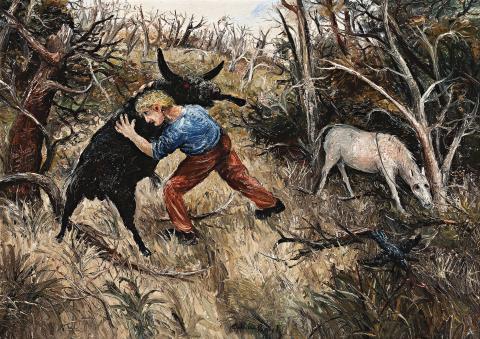THE STRUGGLE, 1956
ARTHUR BOYD
oil on canvas
67.0 x 94.5 cm
signed lower centre: Arthur Boyd
Mr H.D. Reed, Tasmania
Private collection, Sydney
Company collection, Sydney
Company collection, Melbourne
Lawson-Menzies, Sydney, 26 March 2006, lot 77
Jools collection, Sydney
Australian Art: Colonial to Modern, Deutscher Fine Art, Perth and Sydney, August - September 1986, cat.72 (illus. exhibition catalogue)
Arthur Boyd, Savill Galleries, Melbourne, June 2004, cat.9 (illus. exhibition catalogue)
Philipp, F., Arthur Boyd, Thames and Hudson, London, 1967, cat.9-34, p. 260
Fry, G., The Nic Jools Collection, Beagle Press, Sydney and Knox Grammar School, Sydney, 2011, pp. 58, 59 (illus. as ‘The Stockman’)
In a tangled corner of the Australian bush, a stockman struggles to capture a black bull whilst his horse calmly eats grass to one side. These are the bare descriptive details for The Struggle, 1956 ones which mask the painting’s likely inspirational impetus for Arthur Boyd, this country’s master of symbolic and psychologically-charged artworks. It is a restless vision, charged not only by the physical activity it depicts, but also by the agitated marks of the brushwork, the contrasting flashes of colour and the claw-like menace of the skeletal trees; and behind its somewhat simplistic incident lies a far more complex story.
By 1956, when The Struggle was painted, Arthur Boyd had become one of Australia’s most recognisable artists, mostly on the strength of his Wimmera paintings which would, in turn, lead to his invitation to represent Australia in the 1958 Venice Biennale. Unbeknownst to the organisers, Boyd had already started working on his famed series known as ‘the Brides’. At the core of this epic cycle are the themes of lust, loss, guilt and longing, and in many ways, these were also undercurrents in the artist’s own life for Boyd and his wife had only recently concluded a partner-swapping affair with their friends Tim and Betty Burstall. Boyd was renowned for appearing calm and reasonable on the surface but he acknowledged that it was within his art that he could purge himself of guilt and conflicted emotion. To assist him in this, he developed a menagerie of half-men, half-beasts who came to symbolise facets of his character. A key one was the ‘ramox’, a primordial coupling of ox and ram, with curling black horns, bristling with libido and aggressive lust. In The Struggle, the proto-type for the ramox is present, a mighty mallee bull, black and heavy with pendulous testes. Against him is the figure of the hapless stockman, whose stylised profile could be drawn directly from ‘the Brides’ or, indeed, from many of the ceramic works the artist was also creating. All around them are the remnants of Gondwana-land scrub, which Boyd came to consider as being almost pure, an antipodean Garden of Eden, one which he also depicted in contemporaneous paintings such as Mount Terrible (near Gaffney’s Creek), 1956 (exhibited in Venice, former collection Alan Boxer) and Bride Running Away, 1957 (private collection).
This biblical allusion is calculated, for Boyd painted many works with a religious theme and there is a direct echo here of the story of Jacob wrestling with an angel, in particular the famed rendition by Paul Gauguin Vision after the sermon 1888. Indeed, Boyd’s first biographer Franz Philipp once wrote to Boyd that ‘I have always felt that the Old Testament stories attracted you as being “closer to myth” and having a wider range of human experiences including the erotic’.1 This was a prescient comment and one that can easily be applied to the psychological currents churning within this aptly titled painting.
1. Phillip, F., correspondence with Arthur Boyd, 1968, cited in: Anderson, J, "Art history’s history in Melbourne: Franz Philipp in correspondence with Arthur Boyd", The Franz Phillip Memorial Lecture, University of Melbourne, Victoria, 1998, viewed 31 March 2017
ANDREW GAYNOR
